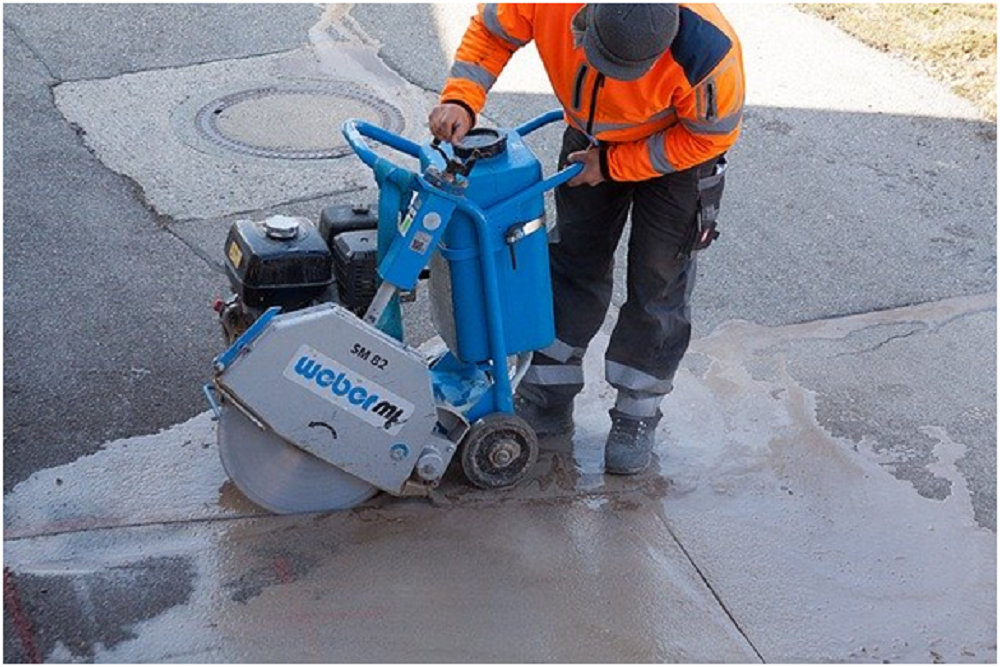
Dust is a major cause of concern when undertaking any project that involves diamond concrete cutting. There are many regulations in place by the authoritative bodies to keep a check on the exposure of the harmful dust to avoid any occupational hazards that may befall the operators and those in the vicinity. While cutting the concrete with a diamond saw there is a big cloud of dust that is inculcated with all sorts of harmful particles that pose a threat of respiratory, eye, and skin diseases in the long haul. Crystalline silica is one of the infamous constituents of the dust flying around while cutting concrete which one needs to be wary of and take appropriate precautions against.
#1. Adopt Wet Cutting as the Primary Practice
Diamond concrete cutting can either be conducted with or without the use of water. In order to avoid dealing with the formation of excessive dust, it is recommended to use wet cutting at all times. The addition of water to mix is extremely effective as it reduces the dust by approximately eighty-five percent. Another aspect of why water is essential for diamond concrete cutting is that it keeps the temperature of the blade in check. Wet cutting can be incorporated in different ways like hosing it directly into the cutting blade, having continuous water flow pumped directly into the cutting area, spaying a water mist in the air to suppress the dust faster or using water jets and pressurized tanks to release water at regular intervals to counter the dust emissions.
#2. Use Certified Protective Gear for the Staff
As mentioned above, the regulatory bodies have clear guidelines for the aversion of occupational hazards. All the project managers should have an idea about the rules and logistically equip their staff with the necessary protective gear. To prevent the inhalation of harmful chemicals and silica particles emitted from the process, high-quality HEPA filter masks should be adorned by the operators to avoid respiratory problems in the future. The eyes must also be protected by safety goggles to keep the eyes safe from chipping concrete and dust clouds. Any contact with the procedure without the use of gloves can get the skin in trouble and lead to lesions in the long haul. Therefore, wearing overalls and protective gloves is extremely important while cutting concrete.
#3. Implement Dust Extraction and Adequate Ventilation
If the project happens to be indoors, one should take care of having some mode of ventilation along with other methods of protection. Also, the dust can be collected at the source by the provision of efficient exhaust ventilation. Dust extraction implemented with the help of high-powered vacuums that are equipped with specialized filters can be a great tool while cutting sawing or drilling concrete. Regularly maintaining the checking of dust collection bags is key to avoid overfilling and clogging for the sake of hygiene and cleanliness. The vacuum system must have a HEPA filter for the segregation of harmful particles. This guarantees a longer-lasting solution for the dust-related issues with the help of some engineering controls in place.
#4. Provide Regular Training Sessions
The personnel handling the diamond concrete cutting should be well-trained on how to keep the dust at bay. The training sessions must be conducted at regular intervals to keep the operators updated about the safety standards and how to uphold them at the site. These sessions can comprise an overview of the potential hazards of exposure to concrete dust like silicosis and chronic obstructive lung disease as well as the methods used by the supervisor to control the airborne dust exposure. The seminars can educate them on the importance of safety while disposing of the waste material collected after their procedures. Lastly, these sessions are of the essence to let the operators know about personal hygiene when working in proximity to dust, like not eating or smoking in the area and implement practical activities to limit the exposure th]o airborne dust.
#5. Lastly, Segregate the Process of Diamond Concrete Cutting
It is standard practice to isolate the process from the operator or other employees by the means of distance, enclosure, or any similar method. It helps to mitigate the effects of the dust produced while working with concrete. It is always better to be mindful of the prevention techniques than having to consider mishaps or accidents.